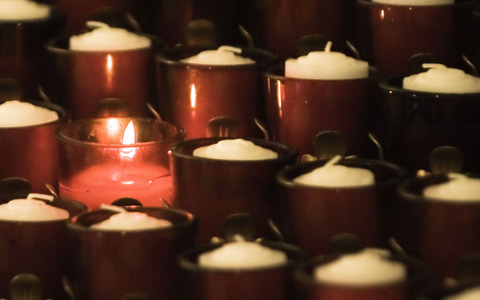
I am currently in Rome on pilgrimage, which is always a bit of a homecoming, since I was blessed to have the opportunity to study in the city twice. I’m often asked by people traveling to the Eternal City what they should absolutely see when they’re there. (This is often asked by people who have not dedicated enough time to the city; trying to see Rome in a day or two is impossible.) It’s a difficult question for me to answer—the places I would list would either be the obvious ones you’ll find on most tourist lists (the four major basilicas, the Vatican Museums, the Flavian Amphitheater) or places that I would want to take you myself, so I could show you what you needed to see. Actually, any place I tell you to go in Rome I would want to take you myself, because it’s too easy to miss something (table of the Last Supper, anyone? How many people miss that in the Basilica of John Lateran?) or because you’ll probably have some silly guide who tells you something absurd, like that no martyrs died in the Colosseum.
There is one place, however, I would always recommend to someone visiting the Rome—something that often escapes the tourist lists, and a place where most of the guides are pretty legit (I’ve only had one bad one, and that was almost ten years ago).
The Scavi.
The Scavi refers to the excavations under St. Peter’s Basilica. Only about 200 people get to go down there each day, so I recommend emailing the office a few months in advance and then praying like crazy.
While I can’t go into every detail about the Scavi, I highly recommend John Walsh’s book The Bones of Peter, which is the definitive book on the gripping story surrounding the excavations. George Weigel also dedicated a chapter in his book Letters to a Young Catholic to a portion of the story (reprinted here: The Scavi of St. Peter’s and the Grittiness of Catholicism).
The present day St. Peter’s is built on centuries of history. It was always assumed that it was built over the tomb of St. Peter, but for centuries this was taken on faith. When the present day basilica was built over the third century basilica, there was no excavation of anything underneath – the present church was simply built on top of the old foundations.
After St. Peter was crucified in the circus of Nero (which ran sort of diagonally to the present basilica and piazza), the Christians cut him down from the cross (most likely leaving his feet behind — that’s the quickest way to remove a person who has been crucified upside down) and buried him in a tomb on the hillside nearby, where there was already an expansive necropolis. Over the years a shrine was built up around his grave, where the Christians would come pray and touch things to his tomb. Eventually, other Christians were buried around him. When Constantine wanted to build a church around the shrine, he was faced with two problems—one, Peter was buried on a hillside. How do you build a giant church on a hillside? And two, to build anything around the shrine would require destroying hundreds, perhaps thousands of tombs—in a necropolis that was still in use. Not only would such an action be illegal, but it would be wildly unpopular and highly suspect, given the Roman respect for the dead.
The fact that Constantine leveled the hill (chopping off the top and using the dirt to fill in the bottom, thus creating an even plane) and destroyed the necropolis is a clear indication that he knew Peter was buried there and it was crucial that he build the church on top of his tomb.
Fast-forward to the twentieth century. Pius XII’s predecessor, Pius XI, asked to be buried in the crypt of the Popes. While making room in the crypt for his grave, the workers broke through the floor of the crypt and made an interesting discovery—they had broken through into an ancient family tomb. Pius XII gave permission for the excavation work to take place, although in secret, and five or six archaeologist spent the next several years discovering the pagan necropolis. This was the pagan necropolis that Constantine had filled with dirt to establish the foundation of his church. The workers slowly removed the dirt and secretly carted it away, the hundreds of thousands of pilgrims above them clueless to what was happening below.
You hear this story and others on the tour, as you make your way through the necropolis, admiring beautiful pagan family tombs, eventually seeing Christian tombs, and then seeing the remnants of the very early shrines and the high altar of Constantine’s original basilica.
(You can do your own little tour here.)
The climax of the tour is when you step into a dark room. You know the tour is almost at an end. You’ve heard the story of the search and you’ve heard about the false alarms, when they discovered bones that clearly were not Peter’s. You wait with expectation. Did they find his bones?
The tour guide begins to describe the graffiti on a certain wall. When they brought a graffiti expert in to decipher the early Christian writing, she discovered the words “Peter is here.” While other remains had been found and determined not to be Peter, she asked that they look at what had been found in the wall. There they found bones—bones of an old man in his sixties or seventies, of robust stature. Bones of almost an entire male body… except the feet.
And there you stand, in the darkness, and peer through glass into lighted excavations. There, in a fiberglass box, you can see bones. And your first instinct is to fall to your knees and weep, knowing that you are looking at the bones of the humble fisherman who walked on water, who denied Christ, and who was told, “Feed my sheep.”
A box of bones on which—literally—a church has been built. For almost two thousand years.













